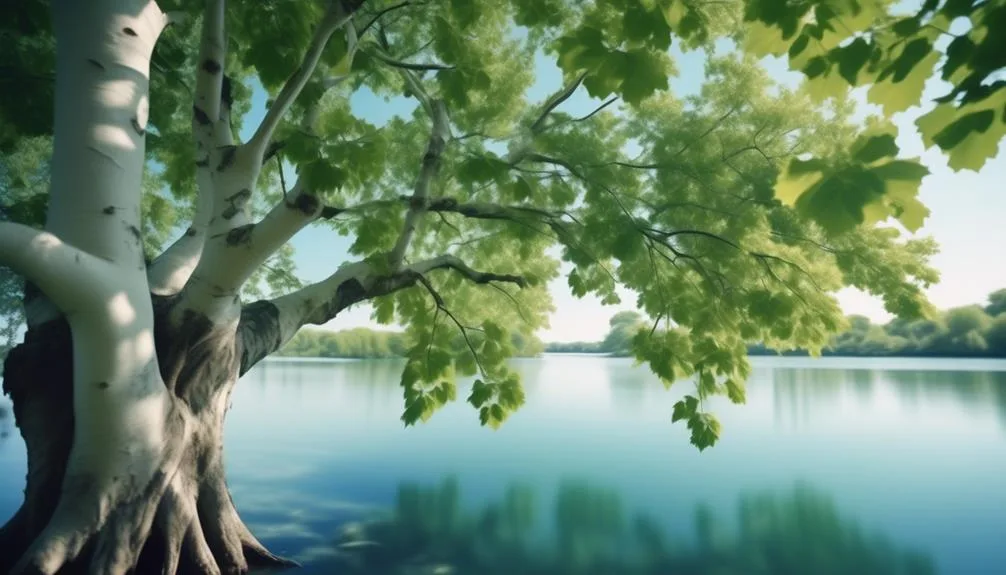Wondering where to plant sycamore trees for the best look? The placement of these grand trees can greatly enhance your surroundings. Whether it's the front yard, backyard, street, park, or waterfront, the location can make a big difference in their appeal.
By exploring different options, you'll find out what factors can make these trees look their best in various settings.
Front Yard Planting
When planning the placement of your sycamore trees in the front yard, consider the visual impact they'll have on the overall landscape. Front yard design is crucial for creating a welcoming and visually appealing exterior. Sycamore trees can significantly enhance your front yard's curb appeal, providing shade, beauty, and a sense of grandeur.
Strategically planting these trees can frame your home, adding depth and interest to the overall design. Consider the mature size of the trees and their proximity to the house and other plants. This will ensure that the trees complement the existing landscape and don't overwhelm the space.
Additionally, think about how the trees will look during different seasons to ensure year-round aesthetic appeal. Proper placement can elevate your front yard's design and enhance the overall curb appeal of your home.
Backyard Landscaping
If you want to create a captivating backyard landscape, consider the placement of sycamore trees to enhance the overall visual appeal of your outdoor space. Here are some tips to maximize the beauty of your backyard through garden design and tree placement:
- Focal Point: Strategically position sycamore trees to create a focal point in your backyard. This can draw the eye and add a sense of balance and symmetry to the overall garden design.
- Shade and Privacy: Use sycamore trees to provide shade and privacy in key areas of your backyard. Their large, broad canopies make them perfect for creating comfortable, secluded spots for relaxation and outdoor activities.
- Complementary Planting: Pair sycamore trees with complementary plants and flowers to create a harmonious garden design that's visually appealing and balanced.
- Framing Views: Utilize sycamore trees to frame beautiful views within your backyard, enhancing the overall aesthetics of your outdoor space.
Street-side Beautification
Enhance the visual appeal of your street-side landscape by strategically planting sycamore trees to create a welcoming and picturesque environment for passersby. Tree lined sidewalks not only add beauty to urban planning but also provide shade and a sense of community.
When considering street-side beautification, it's crucial to plan for tree maintenance and encourage community involvement. Proper maintenance ensures the health and longevity of the trees, contributing to the overall aesthetic appeal of the area. Additionally, involving the community in tree planting and care fosters a sense of pride and ownership, creating a more vibrant and sustainable environment.
Park and Public Spaces
Transforming from street-side beautification to park and public spaces, consider leveraging sycamore trees to create inviting and scenic outdoor areas for community gatherings and leisure activities. Sycamore trees can greatly enhance the aesthetics and functionality of urban parks and public spaces.
Here are some reasons why sycamore trees are ideal for park and public space settings:
- Shade and Comfort: Sycamore trees provide ample shade, making them perfect for creating comfortable spaces for picnics, outdoor events, and relaxation.
- Visual Appeal: Their striking mottled bark and large, lush foliage add to the visual charm of parks and public spaces, contributing to a more picturesque environment.
- Community Engagement: Sycamore trees can serve as focal points for community activities, encouraging social interaction and connection among residents.
- Urban Planning: Their ability to thrive in urban environments makes sycamore trees integral to sustainable urban planning efforts, improving air quality and providing a natural habitat for wildlife.
Incorporating sycamore trees into park and public space designs is a strategic and visually appealing way to enhance community engagement and urban planning.
Waterfront Enhancements
Consider utilizing sycamore trees along waterfront areas to enhance the natural beauty and create inviting spaces for leisure and recreation. Sycamore trees not only provide aesthetic appeal but also offer environmental benefits, making them an ideal choice for waterfront enhancements. By integrating these trees, you can contribute to shoreline restoration and riverbank beautification, creating a harmonious blend of natural and constructed elements. Additionally, their lush foliage and tall stature make them perfect for water feature integration and coastal tree planting, adding a sense of tranquility and charm to the waterfront. The following table highlights the key benefits of incorporating sycamore trees in waterfront areas:
| Benefits | Description |
|---|---|
| Aesthetic Appeal | Enhances the natural beauty |
| Environmental Benefits | Contributes to shoreline restoration |
| Leisure and Recreation Spaces | Creates inviting areas for relaxation |
| Tranquility and Charm | Adds a sense of peace and serenity |
Conclusion
Incorporate the beauty of sycamore trees into your surroundings, whether it's your yard, the street, a park, or by the waterfront.
Let these trees, with their striking bark and lush leaves, add a touch of natural elegance to your landscape.
Happy planting and enhancing the aesthetics of your space with sycamore trees!
Mark Hoffman is a dedicated arborist and tree care specialist with over a decade of experience. His love for trees began when he visited Yosemite National Park as a teenager and was awestruck by the giant sequoias. Mark pursued his passion by studying forestry at Michigan Technological University, where he earned a Bachelor of Science degree.
Since then, he has worked tirelessly in the field of arboriculture, helping to preserve and protect trees in his community. His expertise and dedication have made him a respected leader in the industry and a valuable resource for anyone seeking advice on tree care.
